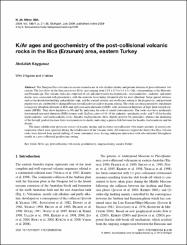K/Ar ages and geochemistry of the post-collisional volcanic rocks in the Ilica (Erzurum) area, eastern Turkey

View/
Access
info:eu-repo/semantics/closedAccessDate
2009Access
info:eu-repo/semantics/closedAccessMetadata
Show full item recordAbstract
The Neogene Ilica volcanics in eastern Anatolia are of sub-alkaline affinity and present features of post-collisional volcanism. The lava flows in the Ilica area reveal K/Ar ages ranging from 13.9 +/- 0.5 to 4.4 +/- 0.3 Ma, corresponding to the Miocene and Pliocene age. The volcanic rocks are composed of calc-alkaline basaltic trachyandesitic-, trachyandesitic-, andesitic- and minor dacitic lavas associated with pyroclastics, with the andesitic lavas being volumetrically the most abundant. Some special textures, such as the dissolution/melting and poikilitic type, and the normal, reverse, and oscillatory zoning in the plagioclase- and pyroxene phenocrysts are attributable to disequilibrium crystallization related to magma mixing. The rocks are characterized by enrichment in large ion lithophile elements (LILE) and light rare earth elements (LREE), with pronounced depletion of high field strength elements (HFSE). They show depletion in Nb and Ta, indicating the role of crustal contamination. The rocks also have moderately fractionated rare earth elements (REE) patterns with (La/Lu)(N) ratios of 10-19 for andesitic- and dacitic rocks, and 7-10 for basaltic trachyandesitic- and trachyandesitic rocks. Basaltic trachyandesites show slightly positive Eu anomalies, whereas the deepening of Eu through gradual increase from trachyandesite to dacite, indicating a genetic link between the basaltic trachyandesite and the dacites. The main solidification processes consist of magma mixing and fractional crystallization with minor amounts of crustal contamination which were operative during the solidification of the volcanic rocks. All evidences support the theory that Ilica volcanic rocks were derived from partial melting of lower continental crust, having undergone interaction with subcontinental lithospheric mantle in a post-collisional geodynamic setting.

















